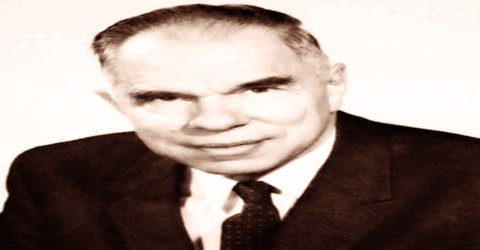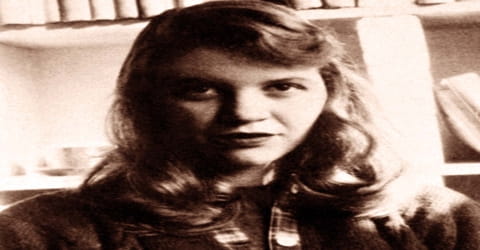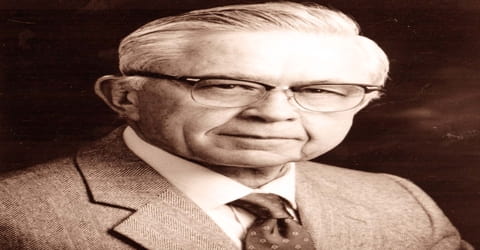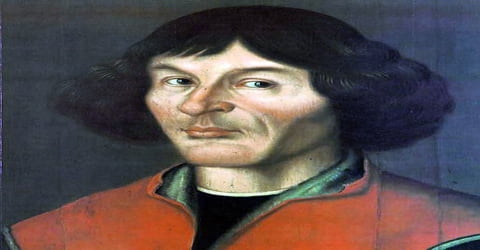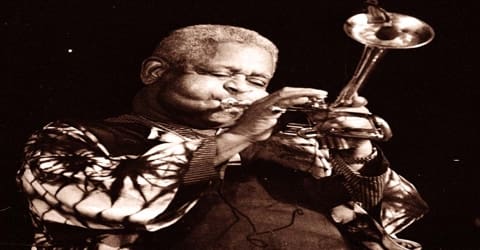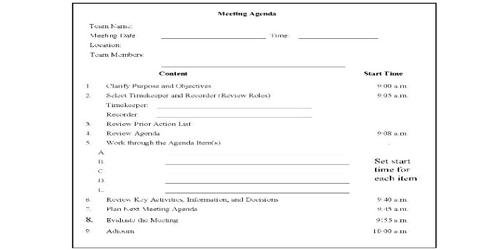Biography of Glenn T. Seaborg
Glenn T. Seaborg – American chemist.
Name: Glenn Theodore Seaborg
Date of Birth: April 19, 1912
Place of Birth: Ishpeming, Michigan, United States
Date of Death: February 25, 1999 (aged 86)
Place of Death: Lafayette, California, United States
Occupation: Chemists
Father: Herman Theodore Seaborg
Mother: Olivia Erickson Seaborg
Spouse/Ex: Helen Griggs (m. 1942)
Early Life

An American nuclear chemist best known for his work on isolating and identifying transuranium elements (those heavier than uranium), Glenn T. Seaborg was born in Ishpeming, Michigan, the U.S. on April 19, 1912, the son of Herman Theodore (Ted) and Selma Olivia Erickson Seaborg. He shared the 1951 Nobel Prize for Chemistry with Edwin Mattison McMillan for their independent discoveries of transuranium elements. Seaborgium was named in his honor, making him the only person for whom a chemical element was named during his lifetime. His work on the electronic structure of elements led to the periodic table being rewritten. He also co-discovered technetium-99m, the most commonly used medical radioisotope in the world.
Seaborg spent most of his career as an educator and research scientist at the University of California, Berkeley, serving as a professor, and, between 1958 and 1961, as the university’s second chancellor. He advised ten US Presidents from Harry S. Truman to Bill Clinton on nuclear policy and was Chairman of the United States Atomic Energy Commission from 1961 to 1971, where he pushed for commercial nuclear energy and the peaceful applications of nuclear science. Throughout his career, Seaborg worked for arms control.
Seaborg and others worked together to discover the ‘trans-uranium elements’ including ‘element 94’ and more than 1000 other isotopes which changed Dmitry Mendeleev’s 1869 Periodic table significantly. He suggested the ‘actinide concept’ of the electronic structure of heavy elements that provided the relationship between the actinides and other elements in the Periodic table. Seaborg and his colleagues discovered nine more new ‘transuranium elements; such as americium, berkelium, curium, californium, fermium, einsteinium, nobelium, and mendelevium. The ninth element ‘element 106’ was named ‘seaborgium’ in his honor which was the first instance of an element to be named after a living person. He was not only famous for fundamental research in nuclear chemistry but also strongly supported and was committed to the education of science. He discovered radioisotopes like ‘cobalt-60’ and ‘iodine-131’ which are used to treat life-threatening diseases. He was an adviser to ten Presidents starting from Franklin D. Roosevelt to George H. W. Bush.
Childhood, Family and Educational Life
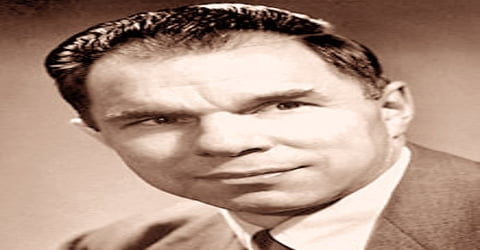
Glenn T. Seaborg, in full Glenn Theodore Seaborg, was born on April 19, 1912, in the small mining town of Ishpeming, Michigan, USA. His father Herman Seaborg and mother Selma Olivia Erickson spoke Swedish at home. He had one sister, Jeanette, who was two years younger. His family spoke Swedish at home. When Glenn Seaborg was a boy, the family moved to Los Angeles County, California, settling in a subdivision called Home Gardens, later annexed to the City of South Gate, California. About this time he changed the spelling of his first name from Glen to Glenn.
As a youth, Seaborg was both a devoted sports fan and an avid movie buff. His mother encouraged him to become a bookkeeper as she felt his literary interests were impractical. He did not take an interest in science until his junior year when he was inspired by Dwight Logan Reid, chemistry and physics teacher at David Starr Jordan High School in Watts.
At elementary school, Glenn Seaborg took no interest in science. At David Starr Jordan High School, located in the Watts neighborhood, Glenn Seaborg’s interest in chemistry and physics was awakened by the exhilarating lessons taught by Dwight Logan Reid. Seaborg graduated from high school at the top of his class, then studied for a Chemistry degree at UCLA, where he graduated in 1933, aged 21. Four years later he was awarded a Ph.D. in Chemistry from the University of California, Berkeley. His Ph.D. thesis was in the field of nuclear chemistry.
Personal Life

(Glenn T. Seaborg and his wife Helen Griggs)
In 1942, Glenn T. Seaborg married Helen Griggs, the secretary of physicist Ernest Lawrence. They had seven children, of whom the first, Peter Glenn Seaborg, died in 1997 (his twin Paulette having died in infancy). The others were Lynne Seaborg Cobb, David Seaborg, Steve Seaborg, Eric Seaborg, and Dianne Seaborg.
Seaborg was an avid hiker. Upon becoming Chairman of the Atomic Energy Commission in 1961, he commenced taking daily hikes through a trail that he blazed at the headquarters site in Germantown, Maryland. He frequently invited colleagues and visitors to accompany him, and the trail became known as the “Glenn Seaborg Trail.” He and his wife Helen are credited with blazing a 12-mile (19 km) trail in the East Bay area near their home in Lafayette, California. This trail has since become a part of the American Hiking Association’s cross-country network of trails. Seaborg and his wife walked the trail network from Contra Costa County all the way to the California-Nevada border.
Glenn T. Seaborg campaigned for the peaceful use of atomic energy and was against the testing of nuclear weapons. Although he was actively involved in making the atomic bomb, he was against its use on the Japanese civilians. Seaborg was fond of athletics and helped found the ‘Athletic Association of Western Universities’ in 1958. His name has figured in the Guinness Book of World records as having the longest entry in ‘Who’s Who in America’.
Career and Works
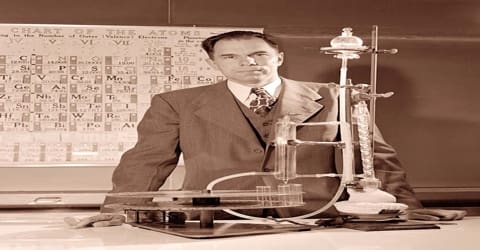
Glenn T. Seaborg was a member of the professional chemistry fraternity Alpha Chi Sigma. As a graduate student in the 1930s, Seaborg performed wet chemistry research for his advisor Gilbert Newton Lewis and published three papers with him on the theory of acids and bases. Seaborg studied the text Applied Radiochemistry by Otto Hahn, of the Kaiser Wilhelm Institute for Chemistry in Berlin, and it had a major impact on his developing interests as a research scientist. For several years, Seaborg conducted important research in artificial radioactivity using the Lawrence cyclotron at UC Berkeley. He was excited to learn from others that nuclear fission was possible but also chagrined, as his own research might have led him to the same discovery.
Seaborg stayed on at Berkeley as the personal laboratory assistant of Gilbert N. Lewis from 1937 to 1939. He also collaborated at Berkeley with physicist Jack Livingood to isolate a number of radioactive isotopes, including iodine-131, which later saved his mother’s life and is now used for the diagnosis and treatment of thyroid disorders. At Berkeley he was, successively, research associate, instructor, and assistant professor (1937-45), becoming a professor of chemistry in 1946. He served as Berkeley’s chancellor from 1958 to 1961.
In 1940 Seaborg discovered the ‘element 94’ later named ‘plutonium’ with the help of his colleagues, Joseph Kennedy, Edwin McMillan, and Arthur Wahl. From 1941 to 1955 he and his colleagues discovered nine more new elements with atomic numbers 95 to 102 and 106. Seaborg, Louis B. Werner, and Burris B. Cunningham first isolated plutonium on August 20, 1942. During the Second World War, Seaborg worked at the ‘Chicago University Metallurgical Laboratory’ as the head of the section dealing with plutonium for the ‘Manhattan Project’. His team isolated separated and concentrated plutonium for use in the atomic bomb at the ‘Clinton Engineering Works’ pilot plant at the Oakridge, Tennessee, and finally at the ‘Hanford Engineer Works, Richland, Washington.
After discovering plutonium, Seaborg’s team continued working with the 60-inch cyclotron, discovering curium (in 1944), americium (in 1944), and berkelium (in 1949). Seaborg became a full professor of chemistry in 1945. Seaborg co-discovered californium in 1950 and mendelevium in 1955 using the 60-inch cyclotron. He also co-discovered the new elements einsteinium and fermium in the fall out from nuclear weapons testing in 1952. Seaborg worked in the research groups that independently discovered nobelium and seaborgium, although the International Union of Pure and Applied Chemistry credits scientists at the Joint Institute for Nuclear Research in Dubna, Russia with the first production of these elements. Except for the discovery of plutonium, Albert Ghiorso was one of Seaborg’s co-workers in all of his element discoveries.
In 1946, Seaborg added to his responsibilities as a professor by heading the nuclear chemistry research at the Lawrence Radiation Laboratory operated by the University of California on behalf of the United States Atomic Energy Commission. Seaborg was named one of the “Ten Outstanding Young Men in America” by the U.S. Junior Chamber of Commerce in 1947 (along with Richard Nixon and others). Seaborg was elected a Member of the National Academy of Sciences in 1948. From 1954 to 1961 he served as associate director of the radiation laboratory. He was appointed by President Truman to serve as a member of the General Advisory Committee of the Atomic Energy Commission, an assignment he retained until 1960. Seaborg served as chancellor at the University of California, Berkeley, from 1958 to 1961.
In 1959 Seaborg helped found the ‘Berkley Space Sciences Laboratory’. He was a member of the ‘President’s Science Advisory Committee’ from 1959 to 1961. In 1961 President Kennedy appointed Seaborg as the Chairman of the ‘Atomic Energy Commission’ which he held till 1971. In 1968 he laid the groundwork for the ‘Treaty on the Non-proliferation of Nuclear Weapons’.
Between 1954 and 1965 Seaborg was granted a total of 43 patents. These were mainly for methods of processing and separating radioactive heavy elements. He also patented methods for producing and separating the element americium. Royalties from the americium patents provided him with an ongoing income after americium became a standard part of smoke detectors.
During the early 1960s, Seaborg became concerned with the ecological and biological effects of nuclear weapons, especially those that would impact human life significantly. In response, he commissioned the Technical Analysis Branch of the Atomic Energy Commission to study these matters further. Seaborg’s provision for these innovative studies led the U.S. Government to more seriously pursue the development and possible use of “clean” nuclear weapons. Seaborg published several books and journal articles during his tenure at the Atomic Energy Commission. He predicted the existence of elements beyond those on the periodic table, the transactinide series and the superactinide series of undiscovered synthetic elements. While most of these theoretical future elements have extremely short half-lives and thus no expected practical applications, he also hypothesized the existence of stable super-heavy isotopes of certain elements in an island of stability.
In 1971 Seaborg returned to the ‘University of California’ at Berkeley as a professor and also as an associate director-at-large of the ‘Lawrence Berkeley Laboratory’. He served as the President of the ‘American Association for the Advancement of Science’ in 1972 and as the President of the ‘American Chemical Society’ in 1976. He served as the Chairman of the ‘Lawrence Hall of Science’ from 1984 to 1999.
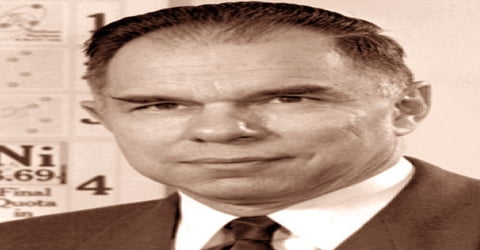
In 1980, Seaborg transmuted several thousand atoms of bismuth into gold at the Lawrence Berkeley Laboratory. His experimental technique, using nuclear physics, was able to remove protons and neutrons from the bismuth atoms. Seaborg’s technique would have been far too expensive to enable routine manufacturing of gold, but his work was close to the mythical Philosopher’s Stone.
In 1983 Seaborg brought out the report ‘A Nation at Risk: The Imperative for Educational Reform’ as a member of the ‘National Commission on Excellence in Education’. Seaborg lived most of his later life in Lafayette, California, where he devoted himself to editing and publishing the journals that documented both his early life and later career. He rallied a group of scientists who criticized the science curriculum in the state of California, which he viewed as far too socially oriented and not nearly focused enough on hard science. California Governor Pete Wilson appointed Seaborg to head a committee that proposed changes to California’s science curriculum despite outcries from labor organizations and others.
Awards and Honor
Glenn T. Seaborg received the ‘Award in Pure Chemistry’ from the ‘American Chemical Society’ in 1947. He received the ‘John Ericsson Gold Medal’ from the ‘American Society of Swedish Engineers’ and the ‘Nichols Medal’ from the ‘New York section of the Society of Chemical Industry’ in 1948.
Glenn T. Seaborg was awarded the Nobel Prize in Chemistry in 1951 when he was just 39 years old. Seaborg shared the prize with Edwin McMillan for their work in discovering elements heavier than uranium.
Seaborg received the ‘John Scott Award and Medal’ from the ‘City of Philadelphia’ in 1953. In 1957 he was awarded the ‘Perkin Medal’ by the ‘American Section of the Society of Chemical Industry’. Seaborg won the ‘Enrico Fermi Award’ from the AEC in 1959.
In 1963 Seaborg was given the ‘Franklin Medal’ by the Franklin Institute, Philadelphia’. He was named the ‘Swedish American of the Year’ by the ‘Vasa Order of America, Stockholm’ in 1962. The American Chemical Society-Chicago Section honored him with the Willard Gibbs Award in 1966.
Seaborg received the ‘National Medal of Science’ in 1991.
In 1997 the element seaborgium was named in Seaborg’s honor; it is the only element ever named after someone who was still living at the time the name was announced.
Death and Legacy
On August 24, 1998, while in Boston to attend a meeting by the American Chemical Society, Glenn Theodore Seaborg suffered a stroke, which led to his death six months later on February 25, 1999, at his home in Lafayette.
Glenn T. Seaborg was the author of The Transuranium Elements (1958), Man-Made Transuranium Elements (1963), Nuclear Milestones: A Collection of Speeches by Glenn T. Seaborg (1972), and A Chemist in the White House: From the Manhattan Project to the End of the Cold War (1998), which chronicles scientific and political issues through his decades of public service, including excerpts from journals and policy-making letters. Shortly after winning the Nobel Prize, Seaborg wrote a number of entries for the 14th edition of the Encyclopædia Britannica, among them the article on plutonium for the 1953 printing.
In April 2011 the executive council of the Committee for Skeptical Inquiry (CSI) selected Seaborg for inclusion in CSI’s Pantheon of Skeptics. The Pantheon of Skeptics was created by CSI to remember the legacy of deceased fellows of CSI and their contributions to the cause of scientific skepticism. His papers are in the Library of Congress. Seaborg received approximately 50 honorary doctorates and numerous other awards and honors. The list of things named after Seaborg ranges from the chemical element Seaborgium to the asteroid 4856 Seaborg. He was a prolific author, penning numerous books and 500 journal articles, often in collaboration with others. He was once listed in the Guinness Book of World Records as the person with the longest entry in Who’s Who in America.
Information Source:
